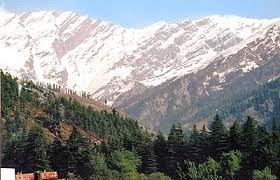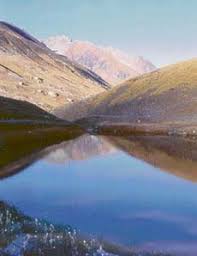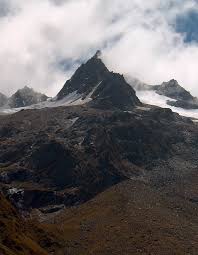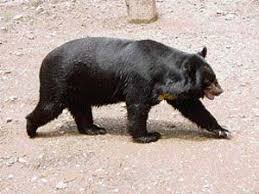Great Himalayan National Park (GHNP) is the newest addition to India's national parks, The National Park with an area of 754 sq. km. is located in Kullu District and has the representative area of temperate and alpine forests of Himachal. It has some the virgin coniferous forests of the State. Vast areas of alpine pastures and glaciers cap this park. This area has many important wildlife species of Western Himalayas The rare and endemic nature of many animal and plant communities at GHNP are of interest not only to scientists, but to lovers of nature worldwide. The World Conservation Monitoring Center has identified GHNP as one of the five Centres of Plant Diversity and Endemism in India.
An area comprising the watersheds of Jiwa, Sainj, and Tirthan rivers became the Great Himalayan National Park in 1984. Starting from an altitude of 1,700 metres above mean sea level, the highest peak within the Park approaches almost 5,800 metres.  The area of the National Park at the moment is 754.4 sq kms and it is naturally protected on the northern, eastern and southern boundaries by permanent snow or steep ridges.However, the total area under the National Park administration is 1,171 sq km.
The area of the National Park at the moment is 754.4 sq kms and it is naturally protected on the northern, eastern and southern boundaries by permanent snow or steep ridges.However, the total area under the National Park administration is 1,171 sq km.
GHNP is a major source of water for the rural and urban centers of the region with four major rivers of the area originating from the glaciers in the Park.  It is also a source of sustenance and livelihood for the local community living close to GHNP. In addition to lumber, the forest environment provides local people with Non- Timber Forest Produce (NTFP) such as honey, fruit nuts, bark of birch and yew, flowers and fuel wood.
It is also a source of sustenance and livelihood for the local community living close to GHNP. In addition to lumber, the forest environment provides local people with Non- Timber Forest Produce (NTFP) such as honey, fruit nuts, bark of birch and yew, flowers and fuel wood.
The general climate of the Park is quite temperate and the best time for visiting is in Spring (April-May) and Fall (September-October). Summer brings monsoon rains and winter brings colder temperatures and the possibility of dangerous snow storms, especially at higher elevations. Being remote and insulated within the Kullu valley, the Park has its own microclimate. At higher elevations, unexpected thunderstorms can soak the unprepared trekker. Just as quickly, the storm can pass, leaving the sky saturated with azure blue.
The Great Himalayan National Park offers the causal hiker and serious trekker a wide range of experiences in the natural wonders of the Park. Trails range from relatively easy day walks in the Ecozone to challenging week or longer treks through arduous and spectacular terrain. GHNP ranks as one of the best national parks in the world and reveals its beauty, diversity, and depth through time spent in exploration. The Park and Kullu region offers excellent opportunities for bird watching, wildlife viewing, religious pilgrimages, cultural tours, and their creation. There are options of rafting, climbing, fishing, attending a village festival, viewing local architecture, and sacred groves. The boundaries of GHNP are contiguous with the Pin Valley National Park in Trans-Himalaya, the Rupi-Bhawa Wildlife Sanctuary in Sutlej watershed, and the Kanawar Wildlife Sanctuary.
Trails range from relatively easy day walks in the Ecozone to challenging week or longer treks through arduous and spectacular terrain. GHNP ranks as one of the best national parks in the world and reveals its beauty, diversity, and depth through time spent in exploration. The Park and Kullu region offers excellent opportunities for bird watching, wildlife viewing, religious pilgrimages, cultural tours, and their creation. There are options of rafting, climbing, fishing, attending a village festival, viewing local architecture, and sacred groves. The boundaries of GHNP are contiguous with the Pin Valley National Park in Trans-Himalaya, the Rupi-Bhawa Wildlife Sanctuary in Sutlej watershed, and the Kanawar Wildlife Sanctuary.  Together the varied wildlife habitats of these protected areas support the full range of Western Himalayan biodiversity, from tropical to alpine and Tibetan. Thus, the Park is a crucial protected area because it connects other islands of biodiversity. Among the large mammals that visitors may encounter, there are several species of herbivores that are characteristic of the Park.
Together the varied wildlife habitats of these protected areas support the full range of Western Himalayan biodiversity, from tropical to alpine and Tibetan. Thus, the Park is a crucial protected area because it connects other islands of biodiversity. Among the large mammals that visitors may encounter, there are several species of herbivores that are characteristic of the Park. The Goral (Naemorhedus goral), a small goat-antelope is found in the lower forests; the Himalayan Tahr (Hemitragus jemlahicus) in the higher forests, and above the tree-line the Bharal, or Blue Sheep (Pseudois nayaur).Among birds, the Park is well known as the most important locality in India for the endangered Western Tragopan. Four other species of pheasant occur in or adjacent to the Park, the one most likely to be seen by visitors is the Himalayan Monal, an abundant bird in the higher forests, although rather shy. Raptors are also a prominent feature of the Park, with Lammergeiers, Himalayan Griffon Vultures, and Golden Eagles being seen regularly. A great variety of other birds occurs, some of which reach their western limit in the Park
The Goral (Naemorhedus goral), a small goat-antelope is found in the lower forests; the Himalayan Tahr (Hemitragus jemlahicus) in the higher forests, and above the tree-line the Bharal, or Blue Sheep (Pseudois nayaur).Among birds, the Park is well known as the most important locality in India for the endangered Western Tragopan. Four other species of pheasant occur in or adjacent to the Park, the one most likely to be seen by visitors is the Himalayan Monal, an abundant bird in the higher forests, although rather shy. Raptors are also a prominent feature of the Park, with Lammergeiers, Himalayan Griffon Vultures, and Golden Eagles being seen regularly. A great variety of other birds occurs, some of which reach their western limit in the Park
GHNP has invaluable rare and endangered species. The Park preserves examples of many ecosystems that have become rare elsewhere in the Himalayas. It will take much time and effort to understand the intricate workings of these ecosystems.It is believed that, if they are not preserved and studied now the unique forests, subalpine shrubberies, and flowery alpine meadows could be destroyed, along with the many animal species that are dependent on them.
Sources: GHNP website and wikipedia
